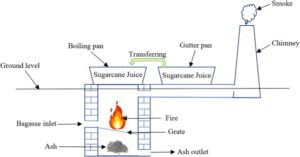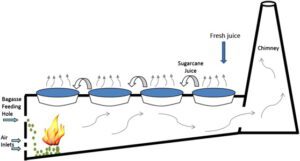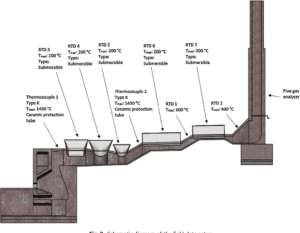Furnaces Used for Jaggery Plants
- Furnaces for jaggery production are essential for the efficient processing of sugarcane juice into jaggery.
- Here are some key points to consider when selecting or designing a furnace for this purpose:
1. Type of Furnace:
- Traditional Furnaces: Often made of bricks, these are commonly used in rural areas. They are relatively simple but can be inefficient and have high fuel consumption.
- Improved Furnaces: Modern designs often incorporate better insulation, air control, and fuel efficiency. Examples include smokeless chulhas or improved biomass furnaces.

Parts of furnace for jaggery making
2. Fuel Type:
- Biomass: Commonly used in traditional furnaces, including bagasse (a byproduct of sugarcane), wood, or other agricultural waste.
- LPG or Natural Gas: Offers better control over temperature but may be more expensive.
- Electric Furnaces: Although less common, they provide precise temperature control and are more environmentally friendly.
3. Efficiency Considerations:
- Thermal Efficiency: Improved furnaces with better insulation and controlled air intake can significantly reduce fuel consumption and increase efficiency.
- Heat Distribution: A good furnace design ensures even heat distribution, which is critical for the consistent quality of jaggery.
- What is the efficiency of traditional jaggery making furnace?
- Conventionally jaggery is produced by evaporation of water in open pans. Furnace is fired using bagasse, which is residue of sugarcane, obtained during juice extraction.
- Furnace heat utilization efficiency is very low, which is ~20% for single, ~30% for two, and 35 to 40% for four pans.
4. Environmental Impact:
- Emissions: Modern furnaces are designed to minimize smoke and harmful emissions, which is important for both worker health and environmental protection.
- Waste Management: Some furnaces can also be designed to recycle or efficiently utilize waste products, such as using bagasse as fuel.
5. Cost and Scalability:
- Initial Investment vs. Long-Term Savings: While improved furnaces may have a higher initial cost, they can offer significant savings in fuel costs over time.
- Scalability: Depending on production needs, the furnace design can be scaled for small-scale or large-scale production.
Conclusion
- Selecting the right furnace for jaggery production depends on factors like the scale of production, available fuel types, and budget.
- An efficient and well-designed furnace can improve productivity, reduce costs, and produce higher-quality jaggery.
- Biomass furnaces represent a sustainable and cost-effective solution for jaggery production, particularly when designed and operated with efficiency and environmental considerations in mind.




